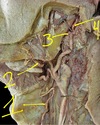Neck Flashcards
Describe the surface anatomy assessment in physical exam
- observation and palpation
- normal v. abnormal
What is the most prominent spinous process at the base of the neck?
- C7
What is the keystone of the neck?
- hyoid
Describe how to palpate the hyoid?
- superior to the laryngeal prominence
What is the Adams Apple?
- laryngeal prominence
What are the landmarks on the hyoid?
- lesser cornu
- body
- greater cornu
Describe the functional role of cervical fascia
- vertical fascial compartments of neck
- “contain” infection, abscess, pathology
Where is the superfiscial cervical fascia?
- anterolateral cervical subcutaneous tissue
What is contained in the superficial cervical fascia?
- platysma
What are the deep cervical fascia layers?
- investing
- pretracheal
- prevertebral
- carotid sheath
- retropharyngeal space
Which layer of deep cervical fascia is indicated by the RED?

- investing
What is contained in the investing layer?
- SCM
- upper trap
What are the two portions of the pretracheal layer?
- muscular
- visceral
Which layer is indicated by the PURPLE?

- pretracheal - muscular portion
Which layer is indicated by the BLUE?

- pretracheal - visceral portion
What is contained in the muscular portion of the pretracheal layer?
- infrahyoid muscles
- suprahyoid muscles
What is contained in the visceral portion of the pretracheal layer?
- larynx
- trachea
- parhynx
What is indicated by the ORANGE?

- prevertebral layer
What is contained in the prevertebral layer?
- scalenes
- other prevertebral muscles
What is indicated by BROWN?

- carotid sheath
What is contained by the carotid sheath?
- common carotid a. (CCA)
- internal carotid a. (ICA)
- internal jugular v. (IJV)
- CN 10 (vagus n.)
What is the space between the prevertebral fascia and the visceral portion of the pretracheal fascia?
- retropharyngeal space
What is the clinical reasoning of the retropharyngeal space?
- allows for expansion of esophagus when swallowing
- trauma
- infection
What is indicated by GREEN?

- buccopharyngeal fascia



















































